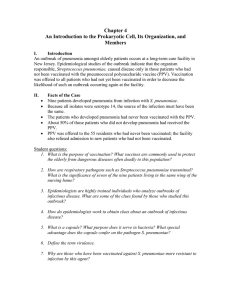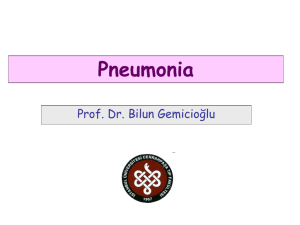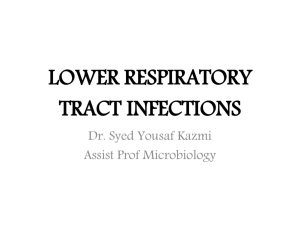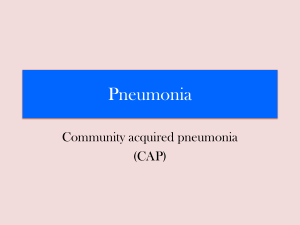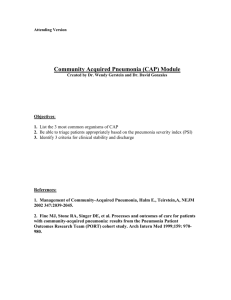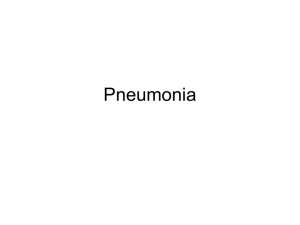Pneumonia - Dr - Individual.utoronto.ca
advertisement
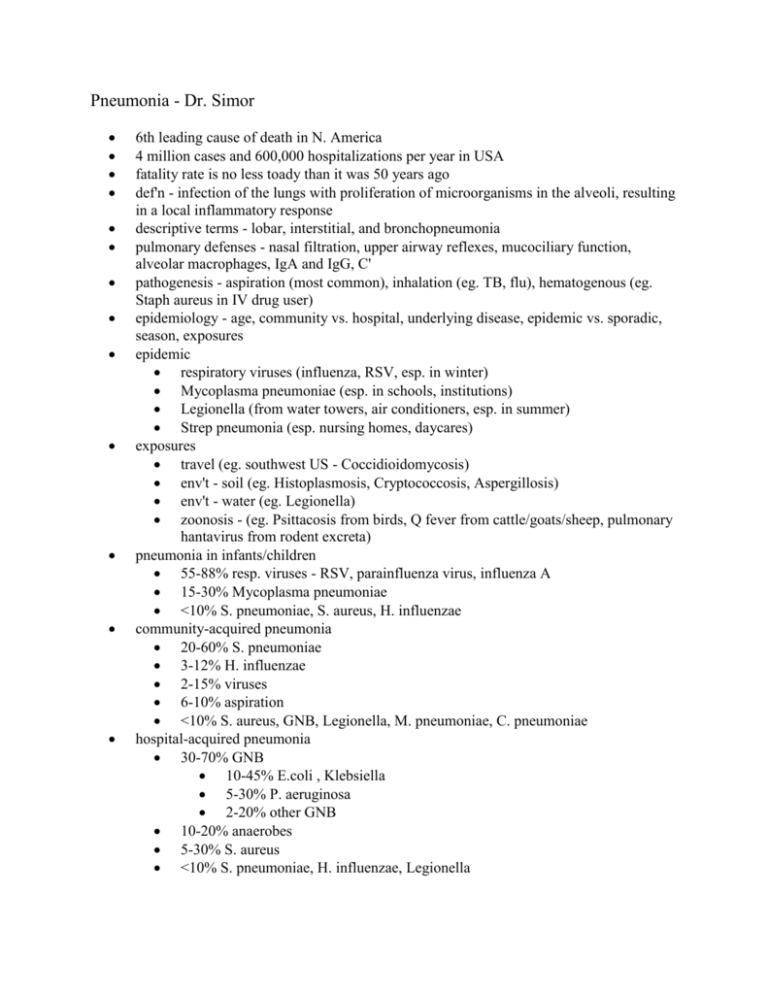
Pneumonia - Dr. Simor 6th leading cause of death in N. America 4 million cases and 600,000 hospitalizations per year in USA fatality rate is no less toady than it was 50 years ago def'n - infection of the lungs with proliferation of microorganisms in the alveoli, resulting in a local inflammatory response descriptive terms - lobar, interstitial, and bronchopneumonia pulmonary defenses - nasal filtration, upper airway reflexes, mucociliary function, alveolar macrophages, IgA and IgG, C' pathogenesis - aspiration (most common), inhalation (eg. TB, flu), hematogenous (eg. Staph aureus in IV drug user) epidemiology - age, community vs. hospital, underlying disease, epidemic vs. sporadic, season, exposures epidemic respiratory viruses (influenza, RSV, esp. in winter) Mycoplasma pneumoniae (esp. in schools, institutions) Legionella (from water towers, air conditioners, esp. in summer) Strep pneumonia (esp. nursing homes, daycares) exposures travel (eg. southwest US - Coccidioidomycosis) env't - soil (eg. Histoplasmosis, Cryptococcosis, Aspergillosis) env't - water (eg. Legionella) zoonosis - (eg. Psittacosis from birds, Q fever from cattle/goats/sheep, pulmonary hantavirus from rodent excreta) pneumonia in infants/children 55-88% resp. viruses - RSV, parainfluenza virus, influenza A 15-30% Mycoplasma pneumoniae <10% S. pneumoniae, S. aureus, H. influenzae community-acquired pneumonia 20-60% S. pneumoniae 3-12% H. influenzae 2-15% viruses 6-10% aspiration <10% S. aureus, GNB, Legionella, M. pneumoniae, C. pneumoniae hospital-acquired pneumonia 30-70% GNB 10-45% E.coli , Klebsiella 5-30% P. aeruginosa 2-20% other GNB 10-20% anaerobes 5-30% S. aureus <10% S. pneumoniae, H. influenzae, Legionella nosocomial pneumonia risk factors recent surgery (thoraco-abdominal) prone to aspiration (decreased LOC) respiratory therapy / intubation immunocompromised > 70 years old bacteria normally present in oropharynx anaerobes, streptococci, staphylococci, Neisseria, Haemophilus, Diphtheroids colonization with gram-negative bacteria associated with severity of illness and duration of hospitalization opportunistic pathogens in immunocompromised patients bacteria - Mycobacteria, Nocardia viruses - CMV fungi - Aspergillus, Candida, PCP Investigation of Pneumonia clinical assessment symptoms - fever, chills, cough, sputum, pleuritic chest pain, dyspnea physical findings - fever, tachypnea (>20/min), crepitations/rales, bronchial breathing neither sensitive nor specific CXR pros - confirm diagnosis, detect other pulmonary disease (eg. carcinoma), document complications, monitor response to therapy (though radiographic improvement may be delayed compared to clinical improvement) cons - can't determine microbial etiology complications lung abscess, empyema / pleural effusion, bacteremia / metastatic infection diagnosis culture of respiratory secretions - sputum, brochoscopy, lung biopsy other cultures - pleural fluid, blood sputum examination oropharyngeal contamination - few WBC, many squamous epithelial cells acceptable sputum - lots of WBC, few SEC false -ve and +ve both quite possible just because you grow an organism doesn't mean that it's causing an infection treat patients, not culture results other diagnostic tests Mycoplasma - nasopharyngeal culture, PCR serology Legionella - culture, direct immunofluorescence, urinary antigen serology Chlamydia - no good test available, can try culture and PCR serology evaluation of patients with pneumonia requiring hospitalization all patients - CXR, ABG, CBC, blood culture, sputum gram stain and culture some patients - urinary Legionella antigen, NP swab for viruses, acute/conv. serology, pleural fluid analysis and culture, sputum for AFB and culture pneumonia treatment supportive therapy - oxygenation, hydration antimicrobials outpatient antibiotics general - macrolide (eg. erythromycin), quinolone (eg. floxacin), doxycycline suspected PRSP (penicillin resistant strep pneumonia) - quinolone suspected aspiration - amoxicillin-clavulanate inpatient antibiotics preferred - cefotaxime/ceftriaxone (cephalosporins) +/- macrolide preferred - quinolone alternate - cefuroxime +/- macrolide aspiration - quinolone + clindamycin aspiration - piperacillin-tazobactam pneumonia prevention influenza vaccine pneumococcal vaccine
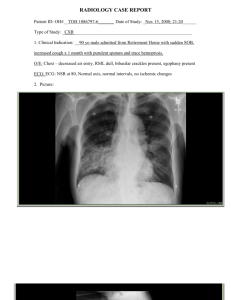
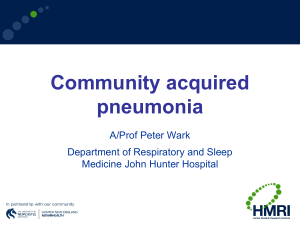
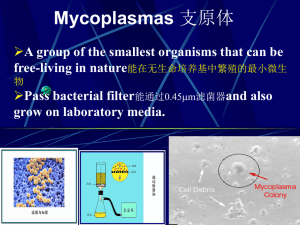
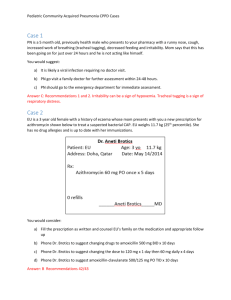
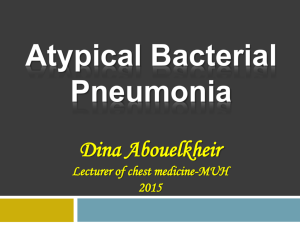
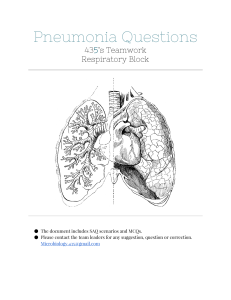

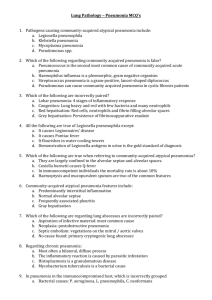
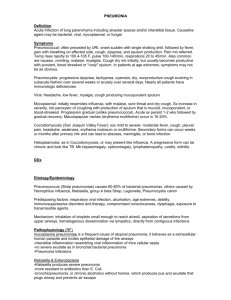
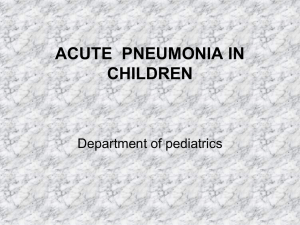
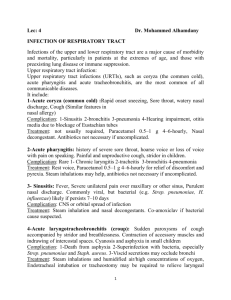
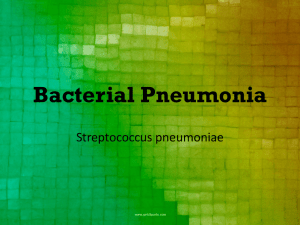
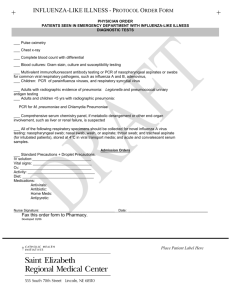
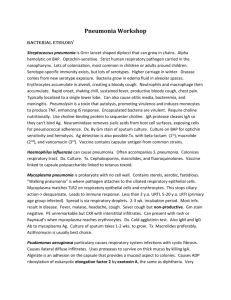
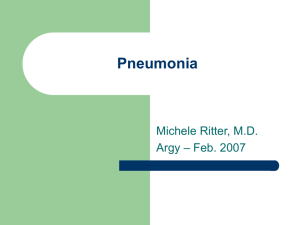
![2- Pneumonia I [Autosaved]](http://s3.studylib.net/store/data/009752027_1-098b5b19a0e3b878ffe76ff65cdcd01d-300x300.png)
